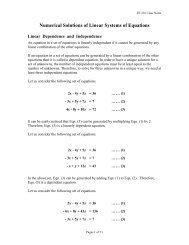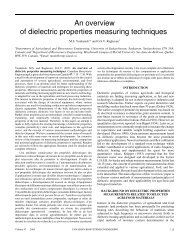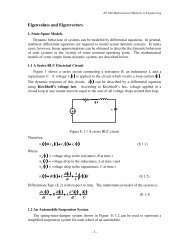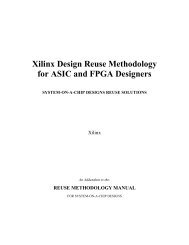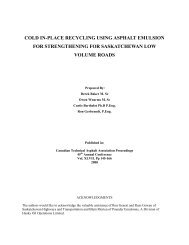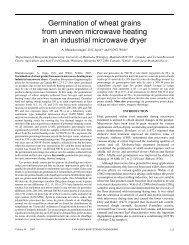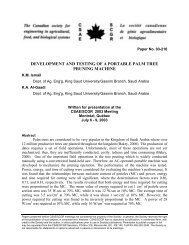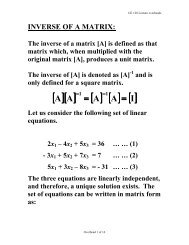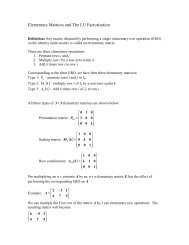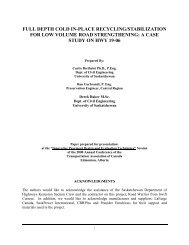Microbial survival and heat generation during online sterilization of ...
Microbial survival and heat generation during online sterilization of ...
Microbial survival and heat generation during online sterilization of ...
You also want an ePaper? Increase the reach of your titles
YUMPU automatically turns print PDFs into web optimized ePapers that Google loves.
(a) Conventional reactor(b) Coil reactorFig. 6. Effect <strong>of</strong> flow rate on the steady-state temperatures (locations <strong>of</strong>thermocouples are shown in Fig. 2.)destruction efficiency <strong>of</strong> the coil reactor increased as a result <strong>of</strong>the development <strong>of</strong> the secondary flow which caused mixingthat increased the exposure <strong>of</strong> microorganisms to UV radiation.On the other h<strong>and</strong>, a flow rate greater than 39 mL/min resultedin a residence time that was too short for microbial destruction.TemperatureFigure 6 shows the variation <strong>of</strong> steady-state temperature withflow rate in the conventional <strong>and</strong> coil reactors. The temperaturesat all locations in the conventional <strong>and</strong> coil reactors decreasedwith increase in flow rate, except for the influent temperature(location 8), which remained constant. At steady state, thetemperatures measured near the bottom <strong>of</strong> the reactors were lessthan the temperatures measured at the top. This was because theliquid (which was kept at room temperature) entered the reactorat the bottom <strong>and</strong> picked up <strong>heat</strong> from the lamp as it traveledupward to the outlet. It was also noticed that the temperaturesmeasured at all the locations in the coil reactor were slightlyhigher than those measured at similarlocations in the conventional reactor. Thiscould be due to the mixing created byDean vortices.The steady state effluent temperature(location 7) decreased from 45.8EC at5 mL/min to 25.5EC at 70 mL/min in theconventional reactor <strong>and</strong> from 46.1EC at5 mL/min to 26.2EC at 70 mL/min in thecoil reactor. The outlet temperaturereported in the literature for various UVreactors varied from 10 to 62.8EC(Koutchma et al. 2004; Tran <strong>and</strong> Farid2004; Mahmoud <strong>and</strong> Ghaly 2004; Abu-Ghararah 1994). According to theenvironmental technology verificationprogram conducted by the EPA (USEPA2002) on UV reactors produced by TrojanTechnologies Incorporated (London,ON),the temperature <strong>of</strong> the effluent will varydepending on the flow rate <strong>and</strong> the reactorgeometry.Heat balanceThe <strong>heat</strong> losses from the bottom <strong>of</strong> thereactors were neglected because: (a) thearea <strong>of</strong> reactor bottom was very small <strong>and</strong>(b) the cheese whey inlet temperature wassimilar to the ambient air temperature. The<strong>heat</strong> gained by the reactor components (q r )was also ignored as there was no otherexternal source <strong>of</strong> <strong>heat</strong> other than the lamp.Therefore, Eq. 1 was rewritten as:qu = qe + qr + qw(42)Since the temperature <strong>of</strong> the reactorhead space (T ia ) <strong>and</strong> the temperature <strong>of</strong> theinside surface <strong>of</strong> the reactor top (T it ) werealmost the same, the convective <strong>heat</strong>transfer coefficient between the innersurface <strong>of</strong> the top <strong>and</strong> the air entrappedinside the reactor (h it ) was ignored. Thecalculated Rayleigh number for the wall outer <strong>and</strong> inner surfaces(Eqs. 17 <strong>and</strong> 18) <strong>and</strong> the top (Eq. 29) for the reactors at the flowrates <strong>of</strong> 5-70 mL/min was less than 1 x 10 9 indicating that theflow was laminar. Equations 15, 28, 14, <strong>and</strong> 26 were used tocalculate h ot , h ow , U t , <strong>and</strong> U w , respectively. While Eqs. 2, 5, <strong>and</strong>3 were used to calculate q e , q w , <strong>and</strong> q 3 , respectively.Table 4 shows the calculated values <strong>of</strong> the various <strong>heat</strong>transfer coefficients <strong>during</strong> steady state in the reactors. Theresults show that the <strong>heat</strong> transfer coefficients <strong>of</strong> the coil reactorwere higher than those <strong>of</strong> the conventional reactor. Rane <strong>and</strong>T<strong>and</strong>ale (2005) stated that the use <strong>of</strong> bends results inenhancement in <strong>heat</strong> transfer due to secondary flows induced inthe bends. Nemeth <strong>and</strong> Bucsky (1997) indicated that thesecondary flow present in curved-tube flow causes a markedvariation in local transfer coefficients around the periphery <strong>of</strong>the tube.Table 5 presents the calculated values <strong>of</strong> the various steadystate <strong>heat</strong> losses <strong>and</strong> the distribution <strong>of</strong> the total energy input in3.8LE GÉNIE DES BIOSYSTÈMES AU CANADA SINGH <strong>and</strong> GHALY



